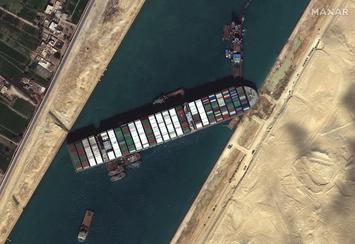
The current Suez Canal blockage has exposed some of Governor Newsom’s fiscal challenges that may be the driving force for the current recall efforts. Under his guidance (I did not use the word leadership), he continues to perpetuate the state’s dysfunctional energy polices and continues to do everything possible to further INCREASE the costs of energy for its 40 million residents.
Recently a massive container ship, the Ever Given, a 220,000-ton container ship that is 1,312 feet long (more than four football fields in length), ran aground in the Suez Canal in March 2021, halting traffic in one of the world’s busiest waterways that may last for weeks. Nearly 19,000 ships passed through the canal during 2020, for an average of more than 50 per day, according to the Suez Canal Authority.
Any restriction to traffic through the 120 mile Suez Canal built 151 years ago directly impacts an upward movement of oil product tanker rates which go straight to the posted price of fuel at the pump for Californians. California should wake up before its energy dependency gets plugged, limiting access to oil from foreign countries that also have less stringent environmental regulations than California and transport their crude oil halfway around the world via air polluting ships delivering that oil to California ports.
California leaders NEVER discuss the nautical distance and the weeks those tankers need to travel to get to California ports. The Suez Canal is particularly important for global oil supplies, and particularly for California’s dependency on foreign suppliers that provide oil to the state from 9,912 nautical miles via the Suez Canal and the Panama Canal. Other foreign sources and the nautical miles from the West Coast ports that California is dependent upon are Ecuador 3,228, Columbia 3,289, Iraq 11,564, and Kuwait 11,494.
The mileage and cost per nautical mile a ship must travel to bring crude to California is huge. A large tanker travels 28 feet on a gallon of residual fuel oil (149,690 BTU or 1.2 gallons of gas). This equals 0.004 mpg. Rather than produce its own oil from the largest oil reserves in America, located in-state, California supports and pays for this use of energy from other distant locations, to get its oil demands met.
If oil tankers must reroute around the Cape of Good Hope at the southern tip of South Africa to keep Asia-northern Europe and Asia-US east coast logistical services running, such a move will generate extra insurance and other shipping costs and delay deliveries by weeks.
As we have all read from the Department of Energy, the USA is now a net exporter of crude oil, with crude oil exports exceeding imports. This oil boom coming from Texas, North Dakota, Pennsylvania, Oklahoma, and Colorado, is beneficial to 49 states, but NOT to California. The American shale boom has important security implications as well, as America is now less dependent on crude oil from the turbulent Middle East, again, except for California.
The insurmountable condition of no pipelines over the Sierra Nevada Mountains results in California having no easy access to the over- supply of USA crude oil east of the Sierra Nevada Mountains. California is an energy island and an energy hog; California is heavily dependent on in-state manufacturing for its fuel demands. California is an “energy island” situated between the Pacific Ocean and the Arizona/Nevada Stateline, with no existing pipelines over the Sierra Nevada Mountains.
Read the rest of this piece at CA Political Review.
Ron Stein is an engineer who, drawing upon 25 years of project management and business development experience, launched PTS Advance in 1995. He is an author, engineer, and energy expert who writes frequently on issues of energy and economics.
Photo credit: Maxar/DigitalGlobe, Inc. via Wikimedia under CC 4.0 License.












